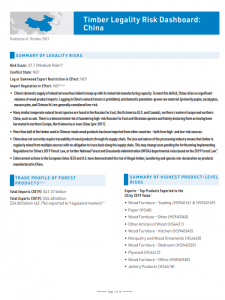Timber Legality Risk Dashboard: China
By Forest Trends View PublicationChina’s domestic supply of industrial wood has failed to keep up with its industrial manufacturing capacity. To meet this deficit, China relies on significant volumes of wood product imports. Logging in China’s natural forests is prohibited, and domestic plantation-grown raw material (primarily poplar, eucalyptus, masson pine, and Chinese fir) are generally considered low-risk.
Many similar temperate natural forest species are found in the Russian Far East, North America (U.S. and Canada), northern / eastern Europe and northern China, such as oak. There is a demonstrated risk of laundering high-risk Russian Far East and Ukrainian species and falsely declaring them as having been harvested in northern Europe, North America or even China (pre-2017).
More than half of the timber used in Chinese-made wood products has been imported from other countries – both from high- and low-risk sources.
China does not currently require traceability of wood products through its supply chain. The size and nature of the processing industry means that timber is regularly mixed from multiple sources with no obligation to trace back along the supply chain. This may change soon pending the forthcoming Implementing Regulations for China’s 2019 Forest Law, or further National Forest and Grasslands Administration (NFGA) departmental rules based on the 2019 Forest Law.
Enforcement actions in the European Union (EU) and U.S. have demonstrated the risk of illegal timber, laundering and species mis-declaration on products manufactured in China.

